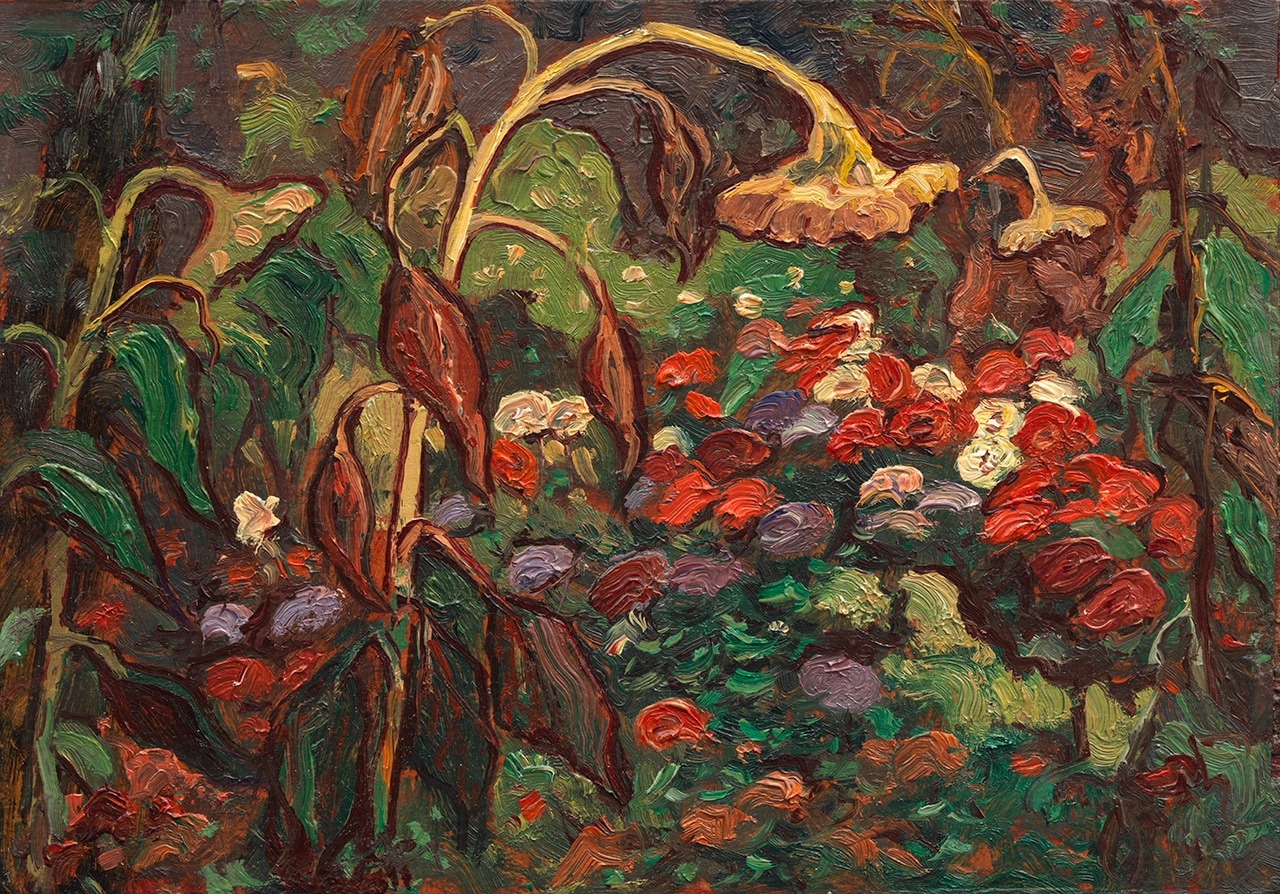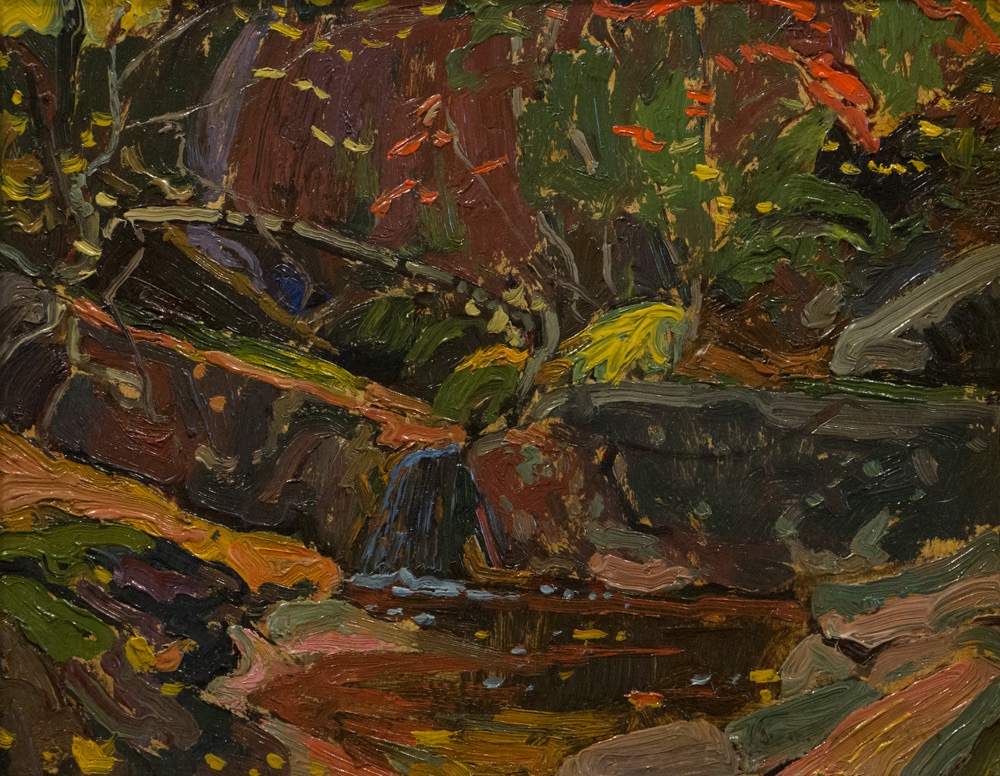La folie des contrefaçons de J. E. H. MacDonald à la Vancouver Art Gallery
“…it is a Vancouver Art Gallery donation. J.E.H. MacDonalds.” read the invitation to me to go to Hamilton’s Arctic Experience Gallery to do Canadian Cultural Property Review Board (CCPERB) appraisals of a collection of J. E. H. MacDonald paintings. It continued, “Outstanding beyond belief.”
“...beyond belief.” Truer words could not have been written.
On July 14, 2014, I visited Hamilton’s Arctic Experience Gallery to see the paintings. After looking at the ten small sketches purported to be by MacDonald, thinking them to be both unusual and unusually fresh, and after a limited dialogue with my hosts, and an increasing discomfort with the pictures, I recused myself from conducting the appraisals.
Several months later I learned the paintings were in fact donated to the Vancouver Art Gallery (VAG) and introduced at a private viewing at the VAG. A report accompanying the donation included the story of their provenance, details of which had previously been unknown to me. The report alleged that the artist had buried the paintings and that several decades later they were dug up by his son, Thoreau, in the company of a gentleman whose family were now donating the paintings to the VAG. When the donation was publicized, Globe and Mail columnist Marsha Lederman published an article explaining the controversy. I published a blog post about my own concerns and my invitation to appraise the paintings. Concerns of authenticity were expressed by numerous members of the art community. The VAG prudently delayed the planned exhibition of the paintings with a view to confirming the authenticity of their incredible acquisitions.
Although it now appears that in 2016 the VAG had absolute proof that J.E.H. MacDonald could not have painted the ten sketches, they chose not to release their findings until 2023 with an exhibition J.E.H. MacDonald ? A Tangled Garden. Despite this irrefutable evidence that these are not J.E.H. MacDonalds, the VAG continues to publicize that: “Visitors will be able to assess the key evidence and come to their own conclusions.” Whereas on the one hand the exhibition seems to be intended to introduce an era of transparency, we are of the opinion that regardless of what some visitors may choose to conclude, the VAG should be unequivocal in declaring these are not by J.E.H. MacDonald. They are pastiches, that is imitations, simply said, fakes. It should be said clearly that there is no artistic value or merit in fake pictures. A fake painting is a sham, a forgery, a counterfeit. It is a cover band posing as the real thing, an imposter. The motive for making a fake anything is usually to deceive.

“I looked at them and said: ‘It’s not by the same artist” (Charlie Hill, 2015)
“The eyes have it” is a well known expression in our art world. The hero in this saga is Charlie Hill, actually his eyes, his ability based on his extensive experience looking, handling and studying J.E.H. MacDonald paintings, to discern pictures not by the hand of the artist. We would refer to this ability as his connoisseurship.
In our opinion, the mistakes made were a combination of a weak acquisition process and expedience at the VAG along with communications mismanagement.
Globe and Mail columnist Ms. Lederman wrote, “Extremely familiar with [J.E.H.] MacDonald’s work and having access to many originals (rather than photographic reproductions), Mr.[Charlie] Hill compared known paintings by the artist with the donated sketches. “I looked at them and said: ‘It’s not by the same artist.’"
His eyes have it! Charlie Hill is a most distinguished art curator, now retired, a gentleman who has immersed his eyes in paintings by the Group of Seven, including J.E.H. MacDonald, for probably close to 60 years. Charlie knows what J.E.H. MacDonald paintings look like.
Many have difficulty in acknowledging that some people actually have developed the ability to discern authorship through years, and often decades, looking at the paintings, drawing upon their visual experience with comparable works by the same artist. This might be referred to as connoisseurship. No one really wants to be known as a connoisseur only because it immediately conjures up an image of some highbrow, British accented, bespectacled gentleman wearing a bespoke Savile Row suit and John Lobb shoes. If you know Charlie, he does not fit that profile.
Many would prefer to think that scientific testing is the answer. Science only supported Charlie Hill’s opinion. Science confirmed Ken Macdonald’s suspicion. Science confirmed that my discomfort with these works was warranted.
What might one have hypothesized if the Canadian Conservation Institute had found the pigments consistent with J.E.H. MacDonald’s lifetime? Would that have meant MacDonald painted these? Of course not! Rule number one for any forger worth his/her salt is to use pigments consistent with those of the artist. Call it reverse engineering. Good forgers of art do not paint Canadian fakes. There is much more money in other markets. How many artists, including Sunday painters, purchased paint from the same supplier MacDonald did? With the logic that any painting that may look like a MacDonald and contains the same pigments as did MacDonald that the work is by him is inaccurate. Analyzing pigments using scientific techniques served to eliminate artists who passed away prior to the availability of some pigments used on these paintings, notably here, J.E.H. MacDonald. It did not tell us who painted these sketches.
Ian Thom and Dennis Reid are two titans of the Canadian art curatorial world. A sound acquisition process at the VAG and the oversight it provides would have averted this error efficiently and given Ian Thom the protection and support he deserved. The discussion and debate provided by an acquisition committee composed of other knowledgeable museum curators, art scholars, conservators and respected art veterans with keen eyes, at minimum, would have led to additional study of these unusually fresh paintings with a spectacular provenance prior to their acquisition and accompanied by appraisals which at least according to the research provided us by our hosts, likely may have totaled upwards of $5,000,000.
It didn’t really take long to figure out that J.E.H. MacDonald did not paint those pictures.
An exemplary process was my experience over a decade as a volunteer on a consultative acquisition committee at the Musée national des beaux arts du Québec under the leadership of one of the truly great Canadian museum directors, John Porter. With the quality of vigilance and support Porter’s acquisition process provided, this unusual and costly donation with an entirely anecdotal provenance, would have at minimum been rejected pending additional study. Acquisitions, be it purchases and donations, were discussed, debated and scrutinized by the museum's curators on one side of the table including luminaries of the Quebec curatorial field including Yves Lacasse, Mario Béland, Michèle Grandbois and Paul Bourassa and, seated on my side, volunteers over the years including a number of highly distinguished academics including Charlie Hill, Esther Trépanier, Laurier Lacroix, Didier Prioul, and David Karel.
“Are you going to believe me or believe your own eyes?”
Rule number one in our gallery is that if the painting doesn’t look and feel 100% right to us, pass, don’t buy it! Our experience is generally that authentic paintings tend to speak for themselves. We’ve heard our share of stories. If we err, we would prefer to err on the side of caution. We regularly remind ourselves of a memorable line from the Marx Brothers’ Duck Soup: “Are you going to believe me or believe your own eyes?” With the best of intentions, Reid and Thom, likely influenced in their judgment by the excitement of a discovery of this importance, and may have been distracted by what we now know was a fanciful story of provenance.

Caution in this case seems to have been replaced by expediency. The VAG seems to have been in a big hurry to get this donation completed. It seems that the Board approved the donation efficiently. The VAG or the donor chose not to donate the paintings as Canadian Cultural Properties. In doing so the paintings were not vetted by The Minister of Heritage’s Canadian Cultural Property Export Review Board. This would have served as a final safety valve for all stakeholders. The VAG’s communications team was not in a comparable rush to disclose that an error had been made. This delay of 7-plus years in releasing their conclusions was unkind to Ian Thom and Dennis Reid.
That is the mystery still not resolved in this initiative of transparency at the VAG. Within months of the initial unveiling of the pictures the fantastic story about the origins and discovery of these pictures was proven as fiction and that the paintings were not authentic. One might imagine that had a tax receipt been issued it would have been rescinded and the pictures would have been returned to the donors who, we are told, originally acquired them for $35 each. (They got their money’s worth.) Uncomplicated one should think, end of story. No harm done and lessons learned.
There was a strong expression of urgency in the invitation to me to go to Hamilton to appraise the paintings and to quickly ascribe values. I was of the impression that our hosts at Arctic Experience Gallery did not actually expect that I would want to inspect the paintings front and back. They had prepared the research for me in a blue folio, apparently to enable me to ascribe values to the paintings right there and then. They were in such a rush to have me put values on the pictures using their research that they didn’t even expend the time to explain why the paintings in front of me looked so fresh and new. As they are entitled to do, when I expressed discomfort with the pictures and refused to appraise the works, they went shopping for others to appraise them.
It may surprise readers that most appraisers, as a rule of thumb, offer appraisals with an extensive and absolute waiver of any responsibility as concerns authenticity. Quite often the appraisers have not physically seen the works of art they are appraising. In most cases they are people who may never have purchased, sold or even held an authentic picture by the artist whose work they are appraising, even one being valued at $500,000! (One highly accredited appraisal society offers a 20 hour course in “connoisseurship.”) That’s material for another story.
What is the takeaway from this? With new leadership at the VAG and a transparent review of what went wrong, we should be confident that curators will receive proper and better support in the acquisition process. The bigger picture, no pun intended, one hopes that museums, large and small, around the country will review their acquisition processes, including the expertise accompanying the work, the quality of the review by their acquisition committees and the quality of the appraisals provided to be assured of proper diligence and vigilance in both spending of funds and remitting tax receipts for donations.
Finally, J E H MacDonald ? A Tangled Garden is a must to visit. It is a must exclusively to admire and celebrate the selection of authentic J.E.H. MacDonald paintings on view.
In conclusion, it is our opinion that this episode should have been averted at the outset. A more rigorous acquisition process to support their curators, a more patient and thorough study of the paintings and, failing that, after their acquisition, transparency, call it damage control if you wish, a quick admission that errors of judgment had been committed and that the paintings are unmistakably fakes. This would have dealt with the matter. No harm done. And, at the resolution of the issue, give credit where credit is due; “I looked at them and said: ‘It’s not by the same artist’” (Charlie Hill, 2015) . The eyes have it.
Comments
Well researched and thought out...as you are wont to do!



